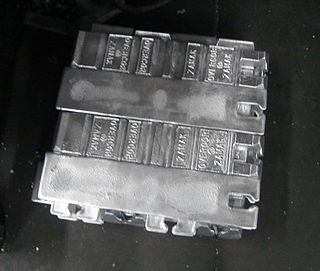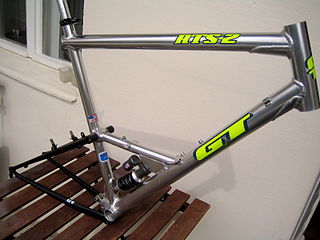Related Research Articles

Aluminium is a chemical element with the symbol Al and atomic number 13. Aluminium has a density lower than those of other common metals, at approximately one third that of steel. It has a great affinity towards oxygen, and forms a protective layer of oxide on the surface when exposed to air. Aluminium visually resembles silver, both in its color and in its great ability to reflect light. It is soft, non-magnetic and ductile. It has one stable isotope, 27Al; this isotope is very common, making aluminium the twelfth most common element in the Universe. The radioactivity of 26Al is used in radiodating.

Bronze is an alloy consisting primarily of copper, commonly with about 12–12.5% tin and often with the addition of other metals and sometimes non-metals, such as phosphorus, or metalloids such as arsenic or silicon. These additions produce a range of alloys that may be harder than copper alone, or have other useful properties, such as strength, ductility, or machinability.

A bicycle frame is the main component of a bicycle, onto which wheels and other components are fitted. The modern and most common frame design for an upright bicycle is based on the safety bicycle, and consists of two triangles: a main triangle and a paired rear triangle. This is known as the diamond frame. Frames are required to be strong, stiff and light, which they do by combining different materials and shapes.
Aluminium–silicon alloys or Silumin is a general name for a group of lightweight, high-strength aluminium alloys based on an aluminum–silicon system, i.e., Aluminium-silicon alloys (AlSi) that consist predominantly of aluminum - with silicon as the quantitatively most important alloying element. Pure AlSi alloys cannot be hardened, the commonly used alloys AlSiCu and AlSiMg can be hardened. The hardening mechanism corresponds to that of AlCu and AlMgSi. The rarely used wrought alloys in the 4000 series and the predominantly used cast alloys are standardizedin the 40000 series. AlSi alloys are by far the most important of all aluminum cast materials. They are suitable for all casting processes and have excellent casting properties. Important areas of application are in car parts, including engine blocks and pistons. In addition, their use as a functional material for high-energy heat storage in electric vehicles is currently being focused on.

ZAMAK is a family of alloys with a base metal of zinc and alloying elements of aluminium, magnesium, and copper.

An aluminium alloy is an alloy in which aluminium (Al) is the predominant metal. The typical alloying elements are copper, magnesium, manganese, silicon, tin, nickel and zinc. There are two principal classifications, namely casting alloys and wrought alloys, both of which are further subdivided into the categories heat-treatable and non-heat-treatable. About 85% of aluminium is used for wrought products, for example rolled plate, foils and extrusions. Cast aluminium alloys yield cost-effective products due to the low melting point, although they generally have lower tensile strengths than wrought alloys. The most important cast aluminium alloy system is Al–Si, where the high levels of silicon (4–13%) contribute to give good casting characteristics. Aluminium alloys are widely used in engineering structures and components where light weight or corrosion resistance is required.
Aluminium–lithium alloys are a set of alloys of aluminium and lithium, often also including copper and zirconium. Since lithium is the least dense elemental metal, these alloys are significantly less dense than aluminium. Commercial Al–Li alloys contain up to 2.45% lithium by mass.
6061 is a precipitation-hardened aluminium alloy, containing magnesium and silicon as its major alloying elements. Originally called "Alloy 61S", it was developed in 1935. It has good mechanical properties, exhibits good weldability, and is very commonly extruded. It is one of the most common alloys of aluminium for general-purpose use.
7075 aluminium alloy (AA7075) is an aluminium alloy with zinc as the primary alloying element. It has excellent mechanical properties and exhibits good ductility, high strength, toughness, and good resistance to fatigue. It is more susceptible to embrittlement than many other aluminium alloys because of microsegregation, but has significantly better corrosion resistance than the alloys from the 2000 series. It is one of the most commonly used aluminium alloys for highly stressed structural applications and has been extensively used in aircraft structural parts.
AA 6063 is an aluminium alloy, with magnesium and silicon as the alloying elements. The standard controlling its composition is maintained by The Aluminum Association. It has generally good mechanical properties and is heat treatable and weldable. It is similar to the British aluminium alloy HE9.
AA 7039 is an aluminum alloy principally containing zinc (3.5–4.5%) as an alloying element. It is heat treatable wrought aluminum alloy. It is used for making armour suites.
7005 is an aluminium wrought alloy used in bicycle frames. Due to its relative ease of welding, it does not require expensive heat treating. It is, however, harder to form, making manufacture more challenging. It has an Ultimate Tensile Strength of 350 MPa, a Fatigue Strength of 150 MPa and a density of 2.78 g/cm3. It does not need to be precipitation hardened, but can be cooled in air.
Sustained load cracking, or SLC, is a metallurgical phenomenon that occasionally develops in pressure vessels and structural components under stress for sustained periods of time.
2014 aluminium alloy (aluminum) is an aluminium-based alloy often used in the aerospace industry.
7068 aluminium alloy is one of the strongest commercially available aluminium alloys, with a tensile strength comparable to that of some steels. This material, also known as an aircraft alloy, is heat treatable.
The Aluminum / aluminum 7049 alloy is a forging aluminum alloy. It has a high stress, corrosion, and cracking resistance and high machinability. Alloy can be hot formed. It can not be weldable.
Aluminium 7116 alloy is heat treatable wrought alloy. It has 4.2 to 5.2 weight percentage of Zinc. It also contains magnesium, copper as small additions.
Aluminium 7150 alloy is a heat treatable wrought alloy. It is used in the aerospace industry for manufacturing aircraft components. Heat treatment can improve its anti-corrosion properties with a low corresponding decrease in strength.
7178 aluminum alloy is wrought alloy. It has high zinc content. After annealing, aluminum alloy 7178 has high machinability. Resistance welding can be used.
7475 aluminum alloy (Adirium) is a wrought alloy with high zinc weight percentage. It also contains magnesium, silicon and chromium.